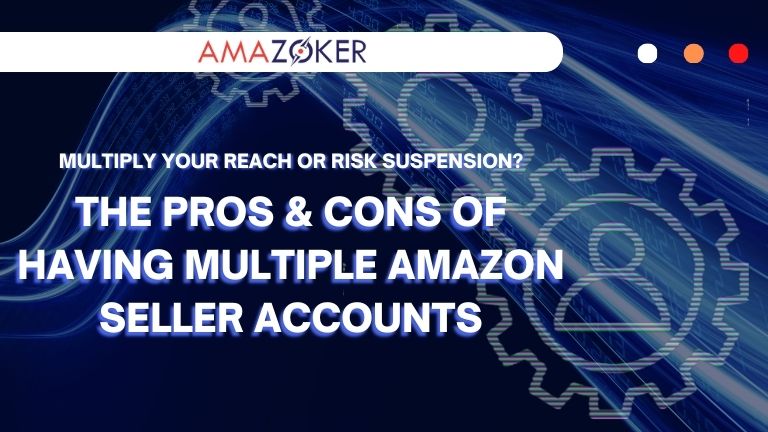For aspiring Amazon sellers, the allure of multiplied success can be tempting. Can having multiple seller accounts truly amplify your reach and profits? While it offers strategic advantages, there are inherent risks to consider. Let’s delve into the world of multiple Amazon seller accounts, exploring both the potential benefits and the pitfalls to navigate.
Table of Contents
Advantages of Multiple Amazon Seller Accounts
Having multiple Amazon seller accounts can bring about several advantages for online sellers. Let’s examine a few of them down there.

Multiple Amazon seller accounts offer advantages for e-commerce retailers
Increased Product Visibility
One of the main reasons why sellers open multiple Amazon seller accounts is to increase their product visibility. By having multiple accounts, sellers can list their products under different categories, allowing them to reach a wider audience. This can be especially beneficial for sellers who offer a variety of products that cater to different niches.
Diversification of Risk
Another advantage of having multiple Amazon seller accounts is that it allows sellers to diversify their risk. In case one account gets suspended or banned, sellers still have other accounts to fall back on. This can be particularly helpful for those who rely solely on Amazon for their income.
Ability to Test Different Strategies
With multiple Amazon seller accounts, sellers have the opportunity to test out different strategies and see which ones work best for their business. For example, they can try out different pricing strategies, marketing techniques, or even experiment with different product listings. This can help sellers determine the most effective approach for their business and increase their chances of success.
Access to Different Marketplaces
Amazon has various marketplaces such as Amazon US, UK, Canada, and more. By having multiple seller accounts, sellers can access these different marketplaces and expand their customer base. This can be especially beneficial for international sellers who want to reach customers in different countries.
Disadvantages of Multiple Amazon Seller Accounts
While there are certainly advantages to having multiple Amazon seller accounts, there are also some disadvantages that sellers should be aware of. Let’s take a look at them below.

There are drawbacks to having multiple Amazon seller accounts that sellers must also consider
Increased Management and Maintenance
Managing multiple Amazon seller accounts can be time-consuming and require a lot of effort. Sellers will need to keep track of inventory, orders, and customer inquiries for each account separately. This can become overwhelming, especially for small businesses or solo entrepreneurs.
Higher Costs
Opening multiple Amazon seller accounts means paying for multiple subscription fees, which can add up quickly. In addition, sellers may also have to pay for additional tools and software to manage their accounts effectively. This can significantly increase the overall costs of running an online business.
Risk of Suspension or Ban
One of the biggest risks of having multiple Amazon seller accounts is the possibility of suspension or even a permanent ban. Amazon has strict policies and guidelines that sellers must adhere to, and any violation can result in account suspension. This can be devastating for sellers who rely solely on Amazon for their income.
Difficulty in Building Brand Reputation
Having multiple accounts can make it difficult for sellers to build a strong brand reputation. Customers may not recognize the seller’s brand if they have products listed under different accounts. This can also lead to confusion and mistrust among customers.
Tips to Avoid Being Suspended Due to Opening Multiple Amazon Seller Accounts
If you’ve decided to open multiple Amazon seller accounts, it’s crucial to follow these tips to avoid being suspended or banned from the platform.

Follow these guidelines when opening multiple Amazon seller accounts
Read and Follow Amazon’s Policies
Before opening multiple accounts, make sure to thoroughly read and understand Amazon’s policies and guidelines. This will help you avoid any violations that could result in account suspension.
Use Different Business Entities
To avoid any confusion or suspicion from Amazon, it’s best to use different business entities for each seller account. Each account must have a unique email address, bank account, credit card, and registered business address. Avoid using the same phone number or IP address for both accounts. For example, if you have a personal account, consider using a separate LLC for your second account.
Keep Track of Your Accounts
Make sure to keep track of all your seller accounts and their respective activities. This will help you identify any issues or potential violations early on and take necessary actions to rectify them.
Separate Inventory & Branding
The products and branding should be distinct across your accounts. Don’t attempt to sell the same items or leverage the reputation of one brand to benefit another.
Don’t Manipulate Reviews or Feedback
Manipulating reviews or feedback is strictly prohibited by Amazon and can result in account suspension. Make sure to follow ethical practices when it comes to customer reviews and feedback.
Performance Matters
Maintain a good seller rating and adhere to Amazon’s policies on each account. A history of negative reviews or policy violations on one account can raise suspicion and jeopardize both.
Be Transparent with Amazon
If you’re planning to open multiple Amazon seller accounts, it’s best to inform Amazon beforehand. This will show that you are transparent and have nothing to hide, which can help prevent any misunderstandings or suspicions from Amazon. Be upfront with Amazon about your reasons for needing multiple accounts. If your business rationale aligns with the advantages mentioned earlier, you’re on the right track.
Seek Professional Help
If you’re unsure about how to handle the situation or find yourself facing suspension due to multiple seller accounts, it may be best to seek professional help, such as Amazoker. Their team of experts specializes in Amazon account reinstatement and can help you navigate the suspension process. They will work with you to develop a plan of action, gather the necessary documentation, and communicate with Amazon on your behalf to get your account reinstated.
In conclusion, having multiple Amazon seller accounts can bring about both advantages and disadvantages for online sellers. It’s essential to carefully weigh these pros and cons before deciding to open multiple accounts. If you do choose to have multiple accounts, make sure to follow Amazon’s policies and guidelines to avoid any suspension issues. And if you do encounter any problems, remember to stay calm and take the necessary steps to resolve the issue.











